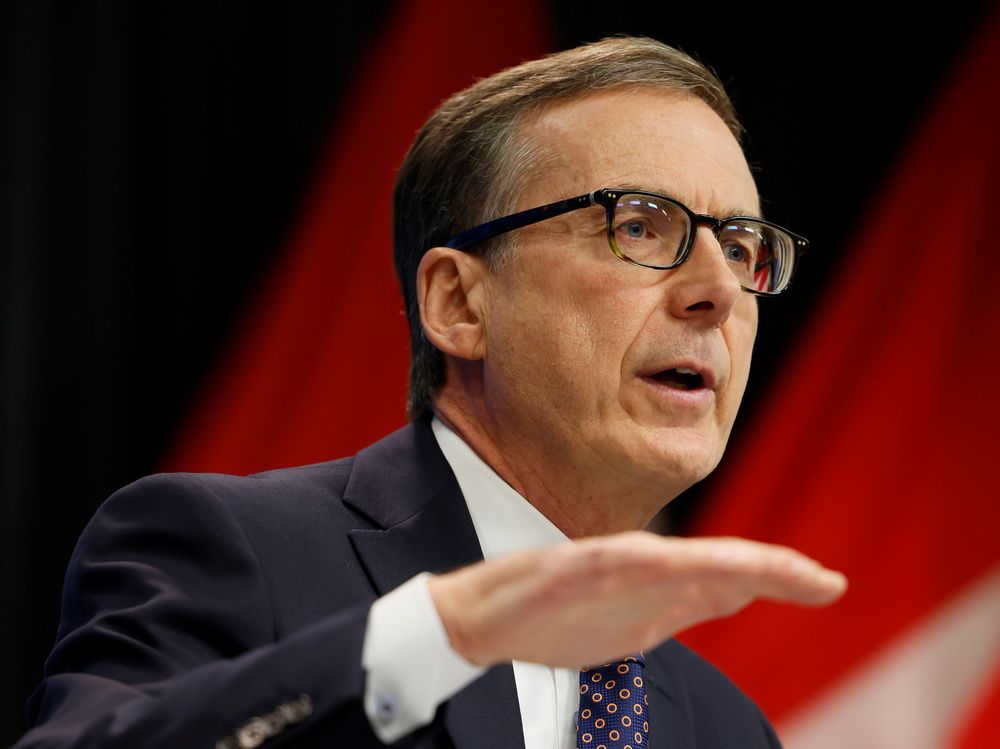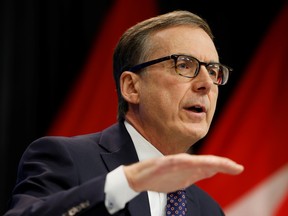‘The economy can handle it’: More rate hikes in store, but Macklem pledges careful path forward

Kevin Carmichael: Comments suggest it’s reasonable to expect quarter-point increases, rather than half-point adjustments

Article content
Bank of Canada governor Tiff Macklem said that war in Europe has “injected new uncertainty,” but not enough to veer off a path to higher interest rates.
Advertisement
Story continues below
This advertisement has not loaded yet, but your article continues below.
Article content
“The economy is now in a place where moving to a more normal setting for interest rates is appropriate,” Mackelm said in a speech on March 3, a day after he and his deputies on Governing Council decided to increase interest rates for the first time in more than three years.
“The economy can handle it,” he added. “We know this will be a significant adjustment, and we fully intend to tighten policy in a deliberate and careful way, being mindful of the impacts and monitoring the effects closely.”
Those comments shed light on the path Macklem will take to get back to a higher interest-rate setting. There is debate on Bay Street and Wall Street about whether inflation will force the Bank of Canada to accelerate its pace, or whether the chaos that has followed Russia’s invasion of Ukraine last week will force central banks to put their plans to raise interest rates on hold.
Advertisement
Story continues below
This advertisement has not loaded yet, but your article continues below.
Article content
It’s not an easy call. The Reserve Bank of Australia this week opted to leave its benchmark rate unchanged near zero, demonstrating that some policy-makers are less spooked by global price inflation than others.
Macklem appears set to try to find a way down the middle of those two approaches. His comments suggest it’s reasonable to expect quarter-point increases, rather than half-point adjustments, a recognition that highly indebted households, which have known little but ultra-low borrowing costs for more than a decade, will be super sensitive to changes in their variable-rate mortgages and interest on their credit cards.
But it also seems likely that Macklem will use each opportunity in his calendar of interest-rate announcements to nudge borrowing costs higher. The next round of policy deliberations is set for April. There are also meetings planned on June 1, July 13, Sept. 7, Oct. 26 and Dec. 7. A quarter-point increase at each of those dates would leave the benchmark rate at two per cent by the end of the year. It was 1.75 per cent prior to the pandemic.
Advertisement
Story continues below
This advertisement has not loaded yet, but your article continues below.
Article content
The Bank of Canada also created hundreds of millions of dollars to purchase government bonds during the pandemic, an aggressive policy called quantitative easing (QE). The central bank is no longer creating money, but it is still purchasing debt with proceeds from expiring bonds. Macklem said the Bank of Canada would eventually stop reinvesting its portfolio, but provided no clues on when he would initiate quantitative tightening (QT).
The governor did say he wouldn’t actively sell the Bank of Canada’s portfolio because most of the debt on its balance sheet is of short duration. That means holdings will naturally shrink relatively quickly once QT begins.
“The timing and pace of further increases in the policy rate, and the start of QT, will be guided by the bank’s ongoing assessment of the economy and its commitment to achieving the two per cent inflation target,”he said.
Advertisement
Story continues below
This advertisement has not loaded yet, but your article continues below.
Article content
Macklem called the situation in Ukraine “deeply troubling.” But in the short term, he seems to have decided that higher commodity prices and the potential for additional supply chain disruption will put even more upward pressure on the consumer price index, which surged to 5.1 per cent in January from a year earlier, the most in more than 30 years.
-

Bank of Canada raises interest rate to 0.5% in first hike since 2018
-

‘The most consequential tightening cycle in decades:’ What economists say about the Bank of Canada hike
-

Bank of Canada signals more rate hikes to tackle inflation
-

Who the rate hike will hit the hardest
The Bank of Canada’s inflation target is two per cent. Post-pandemic supply issues that have become familiar to everyone are largely responsible for the miss, as are surging commodity prices. The Bank of Canada can do little about those things. But it can influence demand, which is strong, too strong at a time when suppliers are struggling to keep up with orders because of supply bottlenecks caused by COVID-19 outbreaks.
Advertisement
Story continues below
This advertisement has not loaded yet, but your article continues below.
Article content
Statistics Canada this week reported that gross domestic product grew at an annual rate of 6.7 per cent in the fourth quarter, much faster than the Bank of Canada expected. Statistics Canada also published evidence that the economy pushed through headwinds from Omicron, as GDP appears to have increased in January, when forecasters thought it would stall or even contract because of strict health measures in Quebec and Ontario that were implemented around the Christmas holidays.
An economy growing at that pace doesn’t need help from a benchmark interest rate that remains near zero.
“Slack in the economy is absorbed, there is solid momentum and inflation is too high,” Macklem said. “Putting it all together, yesterday the bank took the first step on a path to normalizing monetary policy in Canada.”
• Email: [email protected] | Twitter: carmichaelkevin
Advertisement
Story continues below
This advertisement has not loaded yet, but your article continues below.









